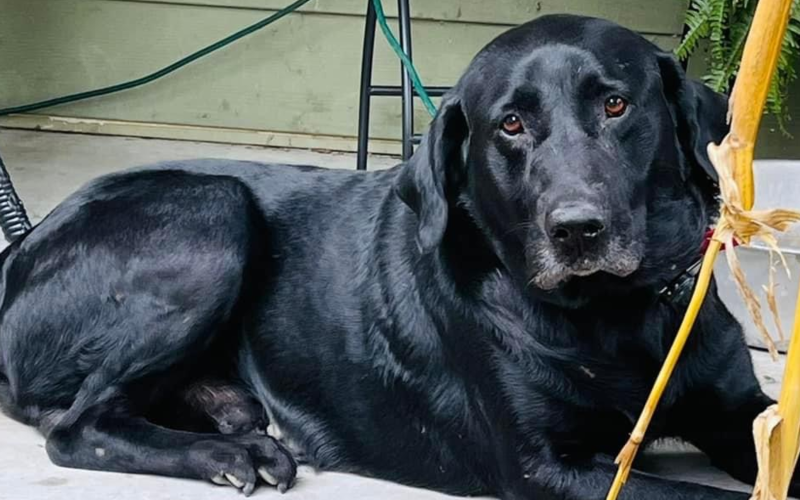Veterinary Neurologist Saves the Life of Dog Hit by Bullet

When 11-year-old Rocky an AKC black lab didn’t come home after he was let out for his usual stroll, his owner, Ashley, didn’t worry too much.
“He would always go outside by himself to use the bathroom and sometimes he would break his barrier to roam around the neighborhood.”
However, when Rocky returned from his rounds of the North Carolina neighborhood, his family noticed right away that something was off by the way he stumbled inside. Trusting their instincts, his family immediately brought him to their primary veterinarian where they conducted an x-ray and blood work. Since Rocky showed no signs of an injury, the primary veterinarian did not suspect that he had endured any head trauma. When the tests came back with no results, they were advised to take Rocky home and keep an eye on him to see if his demeanor improved. Unfortunately, that night Rocky began seizing and had several ‘grand mal’ seizures according to Ashley. Unable to procure any additional care from the nearby veterinary ER, Rocky’s family gave him Trazodone and waited until the next morning to call their primary veterinarian who referred them to a specialist in the eastern corner of North Carolina. Hopeful for some answers, Ashley and her family loaded Rocky into their car and made the four hour drive to the Carolina Veterinary Specialists in Winston-Salem.
When they arrived, they were greeted by Board-Certified Veterinary Neurologist, Dr. Kathryn Bray, who immediately performed an MRI on Rocky to determine the cause of his seizures. The MRI showed that Rocky had an entry wound through his left head muscle and created a hole in his skull. Originally, Dr. Bray assumed that he had punctured himself, which was not uncommon for dogs that are avid bone chewers. However, as the images continued to develop, she noticed that the damage done to Rocky’s brain was much more extensive than a bone or a toy could produce. Due to the ballistic outline in the MRI image, Dr. Bray determined that Rocky had, in fact, been shot in the head.
“Most bullets are metallic and create an artifact on the MRI, shadowing so that you can’t see the image. However, Rocky’s bullet ended up being a lead .22 bullet, which does not interfere with the magnet of the MRI,” said Dr. Bray. “Just to be sure, we x-rayed his head after his MRI and saw the metallic crushed bullet just inside his left skull.”
After this discovery, Dr. Bray discussed the findings with Rocky’s family and told them that she could either attempt to remove the bullet or they could put Rocky to sleep. She also disclosed that, due to the severity of the damage to his brain, Rocky would only have a 50/50 chance of survival if the family went ahead with the removal surgery. Another factor in Rocky’s chance of survival was his age. At 11 years old, Rocky was on the older side for a Labrador whose lifespan generally ranges from 10 to 14 years.
Eager to try anything that would potentially save the life of their furry family member, Rocky’s family decided to have the bullet removed.
According to Dr. Bray the removal surgery was pretty straightforward because the bullet had not been lodged too deeply in Rocky’s skull. The recovery portion would be the most difficult since the damage had already been done. Since there are not many medical findings involving animals with gun trauma, Dr. Bray had to rely on human studies as a way to guide Rocky’s road to recovery.
After a successful surgery, Rocky was kept in a deep sleep for 24 hours, with heavy pain medication and seizure medication to sedate him. Over the next few days, Dr. Bray slowly attempted to reduce the heavy doses of medication while still keeping him comfortable.
“The most difficult part about helping Rocky was waking him up from his medical coma, or heavy sedation, and trying to determine if his barking/crying was from the medications making him foggy or a result of the pain from his wound,” said Dr. Bray. “We could have kept him heavily sedated for days and days, but we knew that we needed to get him to eat and begin trying to walk so that we could transfer his care back home to his family.”
Thankfully after three full days of ups and downs, Rocky was fully awoken from his sedation and began showing signs of responsiveness. Dr. Bray monitored Rocky for the next few days to ensure that he was stable and eating before sending him home to his family where he would begin physical therapy to learn how to walk and run again.
As for Rocky’s overall recovery, Dr. Bray believes that he will continue to improve both cognitively and physically and is likely to make a complete recovery. She describes treating Rocky as a rewarding experience that reaffirmed her passion of being a Board-certified Veterinary Neurologist.
“I am constantly amazed how closely veterinary specialty medicine can mirror what is available to humans for themselves,” said Dr. Bray. “The ability to give Rocky and MRI then operate on his skull to remove a bullet, then nurse him for 10 days from medical coma to rehabilitation, is a huge accomplishment and we are so fortunate to be able to provide this caliber of care to our pet patients. It would not be possible without dedicated owners who advocate for the quality we can provide for their pets.”
Articles by Specialty
- Cardiology (19)
- Large Animal Internal Medicine (23)
- Neurology (17)
- Oncology (21)
- Small Animal Internal Medicine (29)
Articles by Animal
- Cats (35)
- Dogs (52)
- Farm Animals (5)
- Horses (12)
